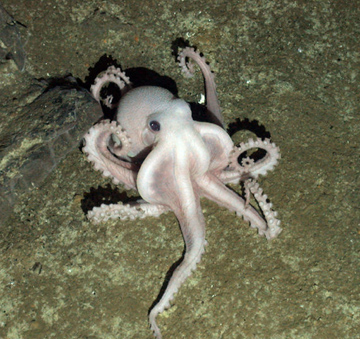291013-east scotia ridge octopus.jpg

An unidentified octopus at the East Scotia Ridge. Credit: Rogers AD, Tyler PA, Connelly DP, Copley JT, James R, et al. 2012
The East Scotia Ridge sounds like something straight out of Jules Verne. It’s an isolated realm in the Southern Ocean where hot, chemical-rich water jets from below the ocean floor. Snow-white crabs with hairy bodies and claws pile atop each other in dense beds – a smorgasbord for seven-armed sea stars that are seen nowhere else on Earth. And a new type of octopus, also white, patrols the warm depths.
The East Scotia Ridge is about 800 miles to the east of the tip of South America. It’s a region where the sea floor is spreading apart, allowing molten rock to push upward and build new crust. Water percolates through cracks in the rocks, where it’s heated to temperatures of up to 700 degrees Fahrenheit. Some of that water shoots out through cracks, or through tall chimneys built from minerals in the super-heated water.
In 2009 and 2011, researchers used a remotely-operated vehicle to explore the ridge, which is a mile-and-a-half deep. It photographed the terrain, measured the temperature, and brought up water samples for analysis.
The volcanic vents are rich in chemicals that support life, from microbes to larger organisms. The crabs and other life may feed on the bacteria, and in turn support other large organisms.
There’s evidence that the life on East Scotia Ridge has been isolated for millions of years. It’s different from that found around other volcanic vents, for example. It may be trapped by the frigid waters around it – preserving an otherworldly realm at the bottom of the sea.

